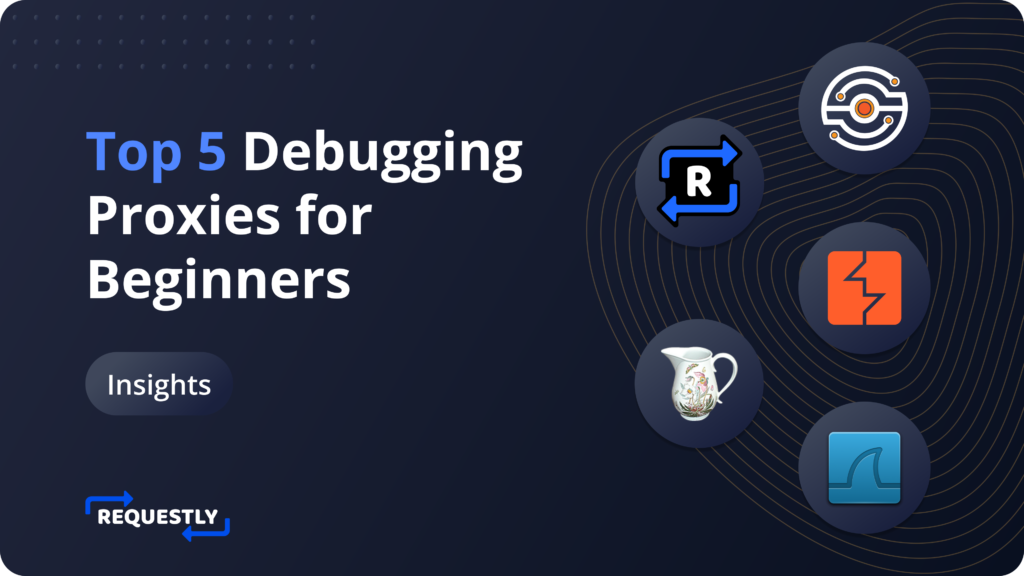Top 5 Web Debugging Proxies for Beginners

Introduction:
A web debugging proxy is a tool that sits between a client (such as a web browser) and a web server, allowing developers and testers to intercept, inspect, and modify the traffic between them. It acts as an intermediary, capturing and analysing HTTP or HTTPS requests and responses exchanged during web communication.
Web debugging proxies are essential for several reasons:
- Traffic Analysis: Debugging proxies enable the analysis of network traffic between a client and a server. They capture and display the actual data being transmitted, including headers, payloads, and cookies. This helps developers understand how web applications communicate and identify any issues or anomalies in the network traffic.
- Debugging and Troubleshooting: Proxies allow developers to inspect and manipulate web requests and responses, making them valuable tools for debugging and troubleshooting. They can be used to identify and fix errors, examine server responses, and analyse the behaviour of web applications. By intercepting and modifying traffic, developers can simulate different scenarios and observe how the application responds.
- Security Testing: Web debugging proxies play a crucial role in security testing. They allow testers to intercept and modify requests and responses, making it possible to identify vulnerabilities such as injection attacks, cross-site scripting (XSS), and insecure data transmission. Proxies with security-specific features can assist in performing penetration testing, vulnerability scanning, and security assessments.
- Performance Optimisation: Proxies help optimise the performance of web applications by providing insights into the network traffic. By analysing requests and responses, developers can identify performance bottlenecks, optimise resource usage, and improve the overall speed and efficiency of their applications.
- API Testing and Development: Proxies are beneficial for testing and developing APIs. They can capture API requests and responses, allowing developers to inspect the data being transmitted, verify proper API behaviour, and debug any issues. Proxies enable API mocking, response manipulation, and testing various scenarios.
- Mobile Device Testing: Proxies are often used for testing web applications on mobile devices. By redirecting mobile device traffic through a proxy, developers can analyse and modify the requests and responses exchanged between the mobile app and the server. This helps in identifying and resolving compatibility issues, network-related problems, and debugging mobile-specific challenges.
In this blog post, we will explore the top 5 web debugging proxies: Charles Proxy, Mitmproxy, Wireshark, Burp Suite, and Requestly.
Charles Proxy:
Charles Proxy is a feature-rich web debugging proxy tool that allows users to intercept, inspect, and modify HTTP/HTTPS traffic. It provides comprehensive features for analysing, manipulating, and recording network traffic, making it a popular choice among developers, testers, and security professionals.
1. Features:
- Intercept and Modify Traffic: Charles Proxy acts as a proxy server, sitting between the client and the server, allowing users to intercept and view HTTP/HTTPS requests and responses..
- Bandwidth Throttling and Network Conditions: Charles Proxy offers the ability to simulate different network conditions such as low bandwidth, high latency, or unreliable connections..
- SSL Proxying and Certificate Generation: Charles Proxy provides SSL proxying, allowing users to inspect and modify encrypted HTTPS traffic..
- Remote Debugging: users can remotely debug devices or browsers connected to different networks.
- Session Recording and Playback: Charles Proxy has the ability to record and save network sessions, including all the requests and responses exchanged during a session.
2. User Interface (UI):
- Charles Proxy offers a user-friendly and intuitive graphical user interface (GUI). The UI provides a comprehensive view of network traffic, including detailed request/response information, headers, timings, and more.
3. Pricing:
- Charles Proxy offers a free trial period for users to explore its features. After the trial, a paid license is required for continued use. Pricing details can be found on the Charles Proxy website.
4. Support:
- Charles Proxy provides several resources for support and assistance, including:
- Online Documentation: Comprehensive documentation is available, covering installation, configuration, and usage of Charles Proxy.
- FAQs and Knowledge Base: The website includes a collection of frequently asked questions and a knowledge base to address common queries and issues.
- Technical Support: Paid users receive access to technical support for any specific questions or technical problems they encounter.
Mitmproxy:
Mitmproxy is an open-source web debugging proxy tool that provides powerful features for intercepting, analysing, and modifying HTTP/HTTPS traffic. It is designed to be a versatile and flexible tool for developers, testers, and security professionals.
1. Features:
- Intercept and Modify Traffic: Mitmproxy acts as a proxy server, allowing users to intercept and inspect HTTP/HTTPS requests and responses between clients and servers. It provides a middleman position, enabling users to monitor and modify network traffic.
- SSL/TLS Decryption and Certificate Generation: Mitmproxy supports SSL/TLS decryption, enabling the inspection and analysis of encrypted HTTPS traffic. It generates SSL certificates that are used to establish a trusted connection between the proxy and the client/server, facilitating the decryption process.
- Scriptable: Mitmproxy is highly scriptable and extensible. It provides a powerful scripting API that allows users to customise and automate various aspects of the proxy’s behaviour. This scripting capability enables users to create custom filters, modify traffic dynamically, and perform advanced manipulations.
2. CLI and Web Interface:
- Mitmproxy offers both a command-line interface (CLI) and a web interface. The CLI provides a powerful and flexible environment for interacting with Mitmproxy through commands and keyboard shortcuts. The web interface offers a more user-friendly and visual way to inspect and modify traffic using a browser-based interface.
3. Active Community Support:
- Mitmproxy has a vibrant and active community of users and developers. The community provides support, shares tips and tricks, and contributes to the ongoing development and improvement of the tool. The official Mitmproxy forum and GitHub repository are great resources for getting help, reporting issues, and finding additional information.
4. Pricing:
- Mitmproxy is an open-source tool and is available for free. The source code is open to the community, allowing users to modify and extend the tool according to their specific requirements.
5. Documentation and Learning Resources:
- Mitmproxy offers comprehensive documentation that covers installation, configuration, and usage of the tool. The documentation provides detailed information about various features, commands, and scripting capabilities.
Wireshark:
Wireshark is a widely used open-source network protocol analyzer that allows users to capture, analyze, and inspect network packets in real time. It is a powerful tool for network troubleshooting, protocol development, and network security analysis.
1. Features:
- Packet Capture and Analysis: Wireshark captures network packets from various interfaces, such as Ethernet, Wi-Fi, and USB, allowing users to analyze the data exchanged between devices on a network. It supports capturing packets in real-time or reading packet capture files from other sources.
- Protocol Analysis and Decoding: Wireshark supports a vast range of network protocols and provides in-depth analysis and decoding capabilities for each protocol. It can dissect and interpret protocol-specific information, enabling users to understand the structure and content of the captured packets.
- Advanced Filtering and Display: Wireshark offers powerful filtering capabilities, allowing users to specify criteria to filter out specific packets for analysis. This feature helps focus on specific network conversations or packets of interest, reducing the noise in large packet captures.
- Packet Reconstruction: Wireshark can reconstruct higher-level protocols such as HTTP, TCP, and UDP streams, allowing users to view the complete conversation between a client and server. This feature is valuable for understanding the flow of data and troubleshooting issues at the application layer.
- Export and Analysis Tools: Wireshark offers various export options to save captured packets or specific packet sections for offline analysis. Users can export packet captures in different formats, including pcap, CSV, XML, and more.
2. Cross-Platform Availability:
- Wireshark is available for multiple platforms, including Windows, macOS, Linux, and various UNIX-based systems, making it accessible to a wide range of users.
3. Pricing:
- Wireshark is an open-source tool and is available for free. The source code is open to the community, allowing users to modify and extend the tool according to their specific requirements.
4. Extensive Community and Documentation:
- Wireshark has a large and active user community that provides support, shares knowledge, and contributes to the ongoing development of the tool. The official website offers extensive documentation, tutorials, and user guides to help users get started and explore the tool’s features.
Burp Suite:
Burp Suite is a comprehensive web application security testing platform developed by PortSwigger. It is widely recognised and used by security professionals, developers, and testers for identifying vulnerabilities, performing security assessments, and enhancing the security posture of web applications.
1. Features:
- Web Application Security Testing: Burp Suite offers a range of tools and functionalities specifically designed for web application security testing. It helps identify common vulnerabilities such as cross-site scripting (XSS), SQL injection, CSRF attacks, and more.
- Intercepting and Modifying Traffic: Burp Suite acts as a proxy between the web application and the client, allowing users to intercept, inspect, and modify the HTTP/S requests and responses. This interception capability enables detailed analysis and manipulation of web traffic.
- Automated Scanning: Burp Suite provides automated scanning capabilities, allowing users to scan web applications for vulnerabilities. It employs various techniques to identify security flaws, including crawling, parameter fuzzing, and vulnerability scanning.
- Manual Testing: Burp Suite’s user-friendly interface supports manual testing, enabling users to interact with web applications and perform security assessments in a controlled manner. Users can manually modify requests, analyse responses, and manipulate parameters to uncover vulnerabilities.
- Session Handling and Authentication Testing: Burp Suite allows users to handle and manipulate session cookies, tokens, and other authentication mechanisms during testing. This feature helps uncover vulnerabilities related to session management and authentication controls.
- Collaborative Tools: Burp Suite offers features for team collaboration, enabling multiple users to work together on security assessments. It allows team members to share information, collaborate on findings, and synchronise their work.
2. User Interface (UI):
- Burp Suite provides a user-friendly and intuitive graphical user interface (GUI). The UI offers various views and tools to analyse web traffic, view request/response details, and manage testing sessions effectively.
3. Pricing:
- Burp Suite offers a free version with limited features, known as Burp Suite Free Edition. It also provides a professional version, Burp Suite Professional, which offers additional features, support, and enhanced functionality at a cost.
4. Support and Documentation:
- Burp Suite provides extensive documentation, including user guides, tutorials, and knowledge base articles, to assist users in getting started and utilising the tool effectively. Support options include an online user community forum and a support portal for Burp Suite Professional users.
Requestly:
Requestly is a versatile web and desktop proxy tool that allows users to modify and control HTTP/HTTPS requests and responses. It offers a range of features designed to enhance web development, testing, and debugging processes.
1. Features:
- Modify Requests: Requestly enables users to modify various aspects of HTTP requests, including URL, headers, query parameters, request method, and more. This feature is valuable for testing different scenarios, simulating specific conditions, or redirecting requests.
- Redirect URLs: Users can set up rules to redirect specific URLs or patterns to different destinations. This is useful for testing different page versions, redirecting requests to local servers, or handling URL routing during development.
- Block Requests: Requestly allows blocking requests to specific URLs or patterns. This feature can be handy for blocking unnecessary requests to external resources, such as ads or analytics scripts, during development or testing.
- Modify Headers: Users can add, remove, or modify headers in HTTP requests and responses. This feature is valuable for testing specific header configurations, setting custom headers for API testing, or simulating different client environments.
- Scriptable Rules: Requestly supports JavaScript-based rules, enabling users to write custom scripts to modify requests and responses dynamically. This provides a high level of flexibility and customisation.
- Browser Extension Integration: Requestly is available as a browser extension for popular browsers like Chrome and Firefox. The extension integrates seamlessly with the browser’s developer tools, making it easy to configure and apply rules directly from the browser interface.
2. Use Cases:
- Development and Testing: Requestly is helpful during web development and testing processes. It allows developers to modify requests and responses on the fly, test different scenarios, simulate server responses, and troubleshoot issues effectively.
- API Testing and Development: Requestly aids in API testing and development by allowing developers to modify requests, headers, and responses. It enables testing different API configurations, mocking API responses, and debugging API-related issues.
- SEO Testing: Requestly can be used for SEO testing purposes, such as redirecting URLs, testing canonical tags, or examining response headers. It helps in ensuring proper SEO implementation and verifying search engine behaviour.
3. Platforms:
- Web: Requestly offers a browser extension that can be installed on popular web browsers like Chrome and Firefox. Users can configure and manage Requestly rules directly from their browser interface.
- Desktop: Requestly also provides a desktop application that offers more advanced features and flexibility. The desktop version allows users to configure system-wide proxy settings, intercept and modify requests from any application, and work with multiple profiles.
4. Support:
- Documentation: Requestly provides comprehensive online documentation that covers various aspects of using the tool, including installation, configuration, and rule creation.
- User Community Forum: Requestly maintains a user community forum where users can ask questions, share ideas, and discuss best practices with other users.
- Email Support: Requestly offers email support for users on paid plans. Users can reach out to the support team for assistance with any technical issues or questions they may have.
5. Pricing:
- Requestly follows a freemium model, offering both free and paid plans. The free version provides access to a wide range of features, while the paid plans unlock additional functionalities and offer enhanced support options.
Summary:
We have discussed about 5 Web Debugging Proxies based on their Features, Pricing, UI, Support and Documentation.
To summarise what we have discussed above:
Contents
Subscribe for latest updates
Share this article
Related posts





















